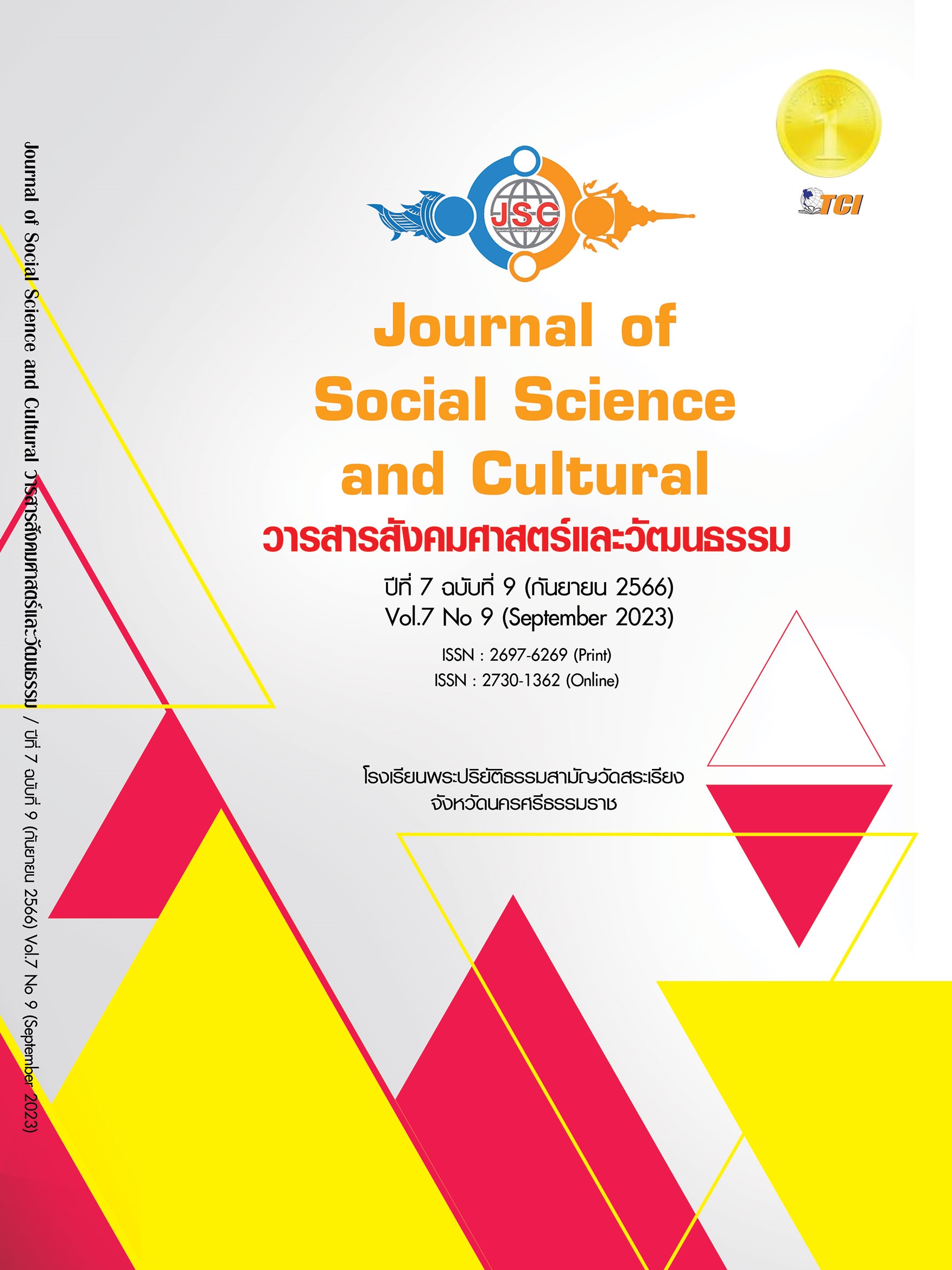THE DEVELOPMENT OF BLENDED TACHING MODEL FOR ENGLISH COMMUNICATION TO ENHANCE LIFE SKILL FOR STUDENTS OF BAN MAHA CHAROEN SCHOOL UNDER SRAKAEW PRIMARY EDUCATIONAL SERVICE OFFICE AREA 1
Main Article Content
Abstract
This research aimed to 1) investigate the basic life skills and blended teaching model 2) development of blended model for English communication to enhance life skill for student 3) implement the blended model for English communication to enhance life skill for student 4) evaluate of blended model for English communication to enhance life skill for students by questionnaire with 83 sample . The results of this research found that’s; 1) the basic life skills and blended teaching model consisted 3components namely; 1.1) English communication teaching blended model to develop life skill were 50:50 1.2) life skill were 4 components namely; Self-awareness and empathy, critical thinking, decision making and creative problem solving, coping with emotion and coping with stress, Interpersonal relationship 1.3) The student's achievement were achievement in English communication and life skill. 2) The blended model for English communication to enhance life skill for student was actually feasibility at the highest level ( = 4.71, S.D. = .70) and propriety at the highest level (
= 4.69, S.D. = .66). 3) The student's achievement in English communication after being taught using was higher than before statistically at the .01 level of significance, and life skill of students total was high level. 4) The related are satisfied to blended model for English communication to enhance life skill for students was the highest level (
= 4.72, S.D. = .72).
Article Details
References
จิรารัตน์ ประยูรวงษ์. (2562). Digital Learning การเรียนรู้ภาษาอังกฤษบนโลกดิจิทัลในศตวรรษที่ 21. วารสารบัณฑิตศึกษา มหาวิทยาลัยราชภัฏวไลอลงกรณ์, 13(1), 210-223.
ชูศรี วงศ์รัตน์. (2551). เทคนิคการใช้สถิติเพื่อการวิจัย. (พิมพ์ครั้งที่ 7). กรุงเทพมหานคร: เทพเนรมิต.
นฐมล สาดบางเคียน. (2556). การพัฒนาเครื่องมือวัดทักษะชีวิต ตามจุดเน้นการพัฒนา คุณภาพผู้เรียนชั้นประถมศึกษาปีที่ 6 สังกัดสำนักงานเขตพื้นที่การศึกษาประถมศึกษากาญจนบุรี เขต 1. วารสารศิลปากรศึกษาศาสตร์วิจัย, 6(1), 10-15.
บุญชม ศรีสะอาด. (2560). การวิจัยเบื้องต้น. (พิมพ์ครั้งที่ 10). กรุงเทพมหานคร: สุวีริยาสาส์น จำกัด.
ประภาพรรณ เส็งวงศ์. (2550). การพัฒนานวัตกรรมการเรียนรู้ด้วยวิธีวิจัยในชั้นเรียน. กรุงเทพมหานคร: อี.เค.บุ๊คส์.
โรงเรียนบ้านมหาเจริญ. (2564). รายงานการประเมินตนเอง ปีการศึกษา 2564. สระแก้ว: โรงเรียนบ้านมหาเจริญ.
ศักดิ์นคร สีหอแก้ว และคณะ. (2558). รูปแบบการสอนเพื่อพัฒนาทักษะชีวิตสำหรับนักเรียนชั้นมัธยมศึกษาในโรงเรียนขยายโอกาสทางการศึกษา. วารสารมนุษยศาสตร์และสังคมศาสตร์ บัณฑิตวิทยาลัย มหาวิทยาลัยราชภัฏพิบูลสงคราม, 9(1), 53-66.
ศิริชัย กาญจนวาสี. (2548). ทฤษฎีการประเมิน. กรุงเทพมหานคร: สำนักพิมพ์แห่งจุฬาลงกรณ์มหาวิทยาลัย.
สกล วรเจริญศรี. (2550). การศึกษาทักษะชีวิตและการสร้างโมเดลกลุ่มฝึกอบรม เพื่อพัฒนาทักษะชีวิตของนักเรียนวัยรุ่น. ใน ดุษฎีนิพนธ์การศึกษาดุษฎีบัณฑิต สาขาจิตวิทยาการให้คำปรึกษา. มหาวิทยาลัยศรีนครินทรวิโรฒ.
สำนักวิชาการและมาตรฐานการศึกษา. (2554). การเสริมสร้างทักษะชีวิตตามจุดเน้นการพัฒนาคุณภาพผู้เรียนระดับ ประถมศึกษา-มัธยมศึกษา. กรุงเทพมหานคร: สำนักวิชาการและมาตรฐานการศึกษา.
Cecibel, V. G. R., Et al. (2020). A Blended Learning System in EFL for Improving Listening and Speaking Competence. Journal of Alternative Perspectives in the Social Sciences, 10(3), 673-690.
Griffin, K. W., & Botvin, G. J. (2003). Effectiveness of a Universal Drug Abuse Prevention Approach for Youth at High Risk for Substance Use Initiation. Preventive Medicine, 36(1), 1-7.
Johnson, D. W. & Johnson, R.T. (2020). The Nuts and Bolts of Cooperative Learning. Minnesota: Interaction Book Company.
Lyst, C. (2020). Coronavirus: What is a blended model of learning? Retrieved May 22, 2020, from https://www.bbc.com/news/uk-scotland-524171.
Olivares, J. (2020). The Enhancement of English-Speaking Ability of the Visually Impaired Students Using Blended Learning. Udon Thani Rajabhat University Academic Journal, 8(1), 56-62.
Serrano, D. R., Et al. . (2019). Technology-enhanced Learning in Higher Education: How to Enhance Student Engagement through Blended Learning. European Journal of Education, 54(2), 273-286.
Spector, et al. (2016). Technology Enhanced Formative Assessment for 21st Century Learning. Journal of Educational Technology & Society, 19(3), 58-71.
Thu My, N., & Minh H, T. (2020). Information Technology Freshmen’ Attitudes towards English Language Learning with Blended Learning Course at FPT Polytechnic College. International Journal of Scientific and Research Publications, 10(8), 665-670.
Visser, P., & Sukavatee, P. (2020). Effects of the Genre-Based Writing Instructional Module in a Blended Learning Environment. Journal of Education Naresuan University, 22(2), 1-17.
Wang, Y. . (2020). A Study on College English High-efficiency Class Based on Blended Teaching Mode of Flipped Classroom in Theory and Practice. Language Studies, 10(9), 1066-1071.


